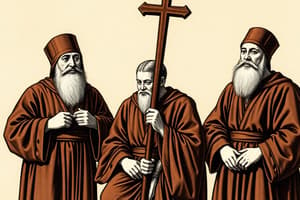Podcast
Questions and Answers
What was the primary reason for the conflict between Jose Rizal's family and the Dominicans?
What was the primary reason for the conflict between Jose Rizal's family and the Dominicans?
- Disputes over the land title of Hacienda de Calamba (correct)
- Religious differences between the families
- Lack of agricultural production on the hacienda
- Involvement of the Spanish government
What does the term 'inquilino' refer to?
What does the term 'inquilino' refer to?
- A land grant given to Spanish settlers
- A ruler from the elite class
- A Spanish conqueror
- A tenant who rented land from the friars (correct)
What was one reason the hacenderos failed to develop their haciendas?
What was one reason the hacenderos failed to develop their haciendas?
- The transient nature of the Spanish population in the Philippines (correct)
- Frequent natural disasters affecting their crops
- Lack of financial support from the Spanish government
- Insufficient labor to work the lands
What is a 'caballero' in the context of land grants?
What is a 'caballero' in the context of land grants?
Which of the following statements about 'sitio de ganado mayor' is true?
Which of the following statements about 'sitio de ganado mayor' is true?
What was the main agricultural focus of the large estates known as haciendas?
What was the main agricultural focus of the large estates known as haciendas?
In the context of the Spanish colonial period, what did 'principales' refer to?
In the context of the Spanish colonial period, what did 'principales' refer to?
What was a significant economic attraction for Spaniards during the colonial period that affected hacienda development?
What was a significant economic attraction for Spaniards during the colonial period that affected hacienda development?
What was a common belief among Filipinos regarding the religious orders' acquisition of land?
What was a common belief among Filipinos regarding the religious orders' acquisition of land?
In the agrarian system of the haciendas, who held the position at the top of the three-tiered system?
In the agrarian system of the haciendas, who held the position at the top of the three-tiered system?
What role did inquilinos play in the agrarian system of haciendas?
What role did inquilinos play in the agrarian system of haciendas?
During which centuries did the social structure of the haciendas primarily develop?
During which centuries did the social structure of the haciendas primarily develop?
What was the primary economic activity that led to changes in the mids-eighteenth century?
What was the primary economic activity that led to changes in the mids-eighteenth century?
What was the usual form of payment for tenants working the hacienda lands?
What was the usual form of payment for tenants working the hacienda lands?
What significant change occurred in the agrarian structure by the mid-eighteenth century?
What significant change occurred in the agrarian structure by the mid-eighteenth century?
Who were the kasama in the agrarian hierarchy of the haciendas?
Who were the kasama in the agrarian hierarchy of the haciendas?
Study Notes
The Origin of Friars Estates in the Philippines
- Religious orders acquired lands through various methods, including donations from Spaniards seeking spiritual benefits, purchases of heavily mortgaged estates, and donations and sales from Filipino principales.
- The lands were originally granted to Spanish conquistadores in the late sixteenth and early seventeenth centuries.
- The grants included large tracts of land called sitios de ganado mayor (1,742 hectares) and smaller tracts called caballerias (42.5 hectares).
- These lands were often underdeveloped due to the transient nature of the Spanish population, the small market for livestock products, and the economic opportunities offered by the Galleon Trade.
- By the nineteenth century, religious estates in the Tagalog region encompassed nearly 40% of the provinces of Bulacan, Tondo (present-day Rizal), Cavite, and Laguna.
Agrarian Relations on the Haciendas
- Early agrarian relations on the haciendas were characterized by lay brother administrators under the authority of the heads of religious orders.
- Tenants were expected to work the land and pay an annual rent, often in the form of a fixed amount of harvest or money.
- An expanding economy based on exporting agricultural crops in the mid-eighteenth century led to the development of the inquilino system.
- Under this system, an individual rented land for a fixed annual amount called a canon, and was also expected to provide personal services to their landlords.
- Inqulinos subleased the land to kasamas (sharecroppers) who cultivated the soil.
- This created a three-tier system with landlords at the top, inquilinos in the middle, and sharecroppers at the bottom.
- This system freed the religious hacenderos from direct interaction with the kasamas and allowed them to avoid the responsibilities of forced labor demands from the Spanish government.
- The kasamas benefited from this arrangement because their labor obligations kept them from being subject to forced labor demands.
Studying That Suits You
Use AI to generate personalized quizzes and flashcards to suit your learning preferences.
Description
Explore how religious orders in the Philippines acquired lands from the Spanish colonizers through donations and purchases. This quiz covers historical land grants, characteristics of friars' estates, and their impact on agrarian relations in the Tagalog region during the colonial period.




